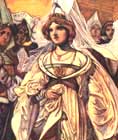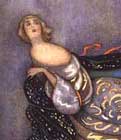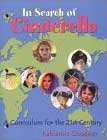
Cinderella:
345 Variants
by Marian
Roalfe Cox
SurLaLune's
Cinderella Area
SurLaLune Fairy Tales Main Page
232
Cosquin, E., Contes populaires de Lorraine. 1886. i, pp. 246-247. Story No. XXIII.
"THE GOLDEN PEAR-TREE."
ABSTRACT
Ill-treated heroine (by mother)--Menial heroine, minds sheep; has stones given her for bread--Fairy man aid - -Helpful animal (sheep) gives food when struck with magic wand--Second daughter, sent to spy on heroine, falls asleep. Eldest daughter feigns sleep and reports to mother--Slaying of helpful animal--Heroine collects bones from which springs golden pear-tree-- King sees tree; he will wed anyone who can pluck golden pears. Elder sisters try and fail; branches bow down to heroine --Happy marriage--King goes to war. Queen hears twins with gold star on brow; and dog has two puppies with gold star. King's mother accuses queen of bearing puppies. King sends order for heroine to be hanged.
TABULATION
(1) Father and mother have three daughters; mother hates youngest and sends her daily to mind sheep, giving her bag of stones instead of bread.-- (2) One day, whilst searching for strawberries, heroine is met by man, who, learning that she seeks food, gives her a wand with which to strike the biggest sheep, and obtain all she wants. Man disappears. Heroine strikes sheep, and sees spread before her a table with bread, wine, meat, and sweets. After she has feasted, table disappears.-- (3) This happens every day, till mother wondering why heroine looks well-nourished, sends second daughter to spy on her. Second daughter falls asleep; meanwhile heroine procures food as before. Second daughter returns to say heroine has neither eaten nor drunk; but mother suspecting second daughter was asleep, sends eldest next day.-- (4) She pretends to sleep, and sees heroine feed, and reports to mother. Mother feigns illness, and asks father to kill biggest sheep, and will not have fowl instead. Sheep is killed.-- (5) Heroine hunts for strawberries and blackberries; same man appears and bids her collect all the bones of sheep, and put them in a heap near the house. Heroine does so, and golden pear-tree springs from the bones.-- (6) One day, when she is in the fields, king passes by house and, seeing pear-tree, declares he will wed whomsoever can pluck golden pears. Elder daughters try, but branches stretch up higher and higher, and they cannot reach fruit. Heroine returns, and says she will climb tree; mother tries to dissuade her. Branches bow down to her; king marries her.-- (7) A year after, whilst king is at the war, queen bears twins, each with gold star on brow. At the same time dog has two puppies with gold star. King's mother writes to him, saying heroine has borne two puppies.1 -- (8) King, enraged, sends order, afterwards executed, for heroine to be hanged.
NOTES
Note 20
(P. 200.) With accusation of queen, compare similar incidents in Arnason, pp. 370, 416, 429; Cosquin, i, 186; Crane, p. 19; Coelho, p. xviii; Fleury, p. 151; Folk-lore Record, i, 116, 207; F.-L. Journal, vi, 38 (Aino tale); Frere, O. D. D., No. 4, pp. 17-22, 54; Gonzenbach, Sic. Mar., i, 19, 148, No. 24; Grimm, No. 31, and i, 364; Gubernatis,i, 412; Hahn, "Sun, Moon, and Morning Star"; Karajich, No. 33; Leskien, No, 46; Magyar Tales, pp. 337, 338; Prohle, i, No. 36; Roman de la Manekine; Satuja ja Tarinoita, i, 105; Schiefner, No. 12; Schneller, No.50; Schott, "Die Goldnen Kinder"; Sêbillot, i, No. 15; Spitta-Bey, No. 11; Stier, "Die verwandelten Kinder"; Ungarische Sagen, "Die beiden jungsten Konigskinder; Stokes, No. 20; Theal, p. 148; 1001 Nights, "The Envious Sisters"; Vernaleken, p. 35, and comp. p. 33; Webster, 177; Zingerle, ii, 124.
Compare the following story, which contains also other incidents common in Cinderella tales:--
Jahrbuch für romanische und englische Literatur. Leipzig, 1860. Vol. vii. "Italienische Märchen", by Hermann Knust. Pp. 382-84. (A Tuscan story from Livorno.)
"DER KONIGSSOHN UND DIE BAUERNTOCHTER."
At his father's wish, a king's son sets out with his attendant to seek a bride. Attendant tries in vain to induce master to notice the pretty women in the town and neighbouring country. At night they come to a wood, and seek shelter from the storm in a peasant's hut. Peasant receives them hospitably, and his wife prepares the table for a meal. King's son inquires for whom the fifth place is laid, and learns that it is for peasant's daughter, who is too shy to appear. Directly he sees her, king's son tells attendant that she shall be his bride. He asks permission to carve the fowl, and gives the father the head, the mother the carcase, and the legs and wings to daughter, whilst he and his attendant eat the flesh.A Next morning he asks for the hand of peasant's daughter, and goes home to his father, who gives him fine carriage in which to fetch his bride. The queen is angry at the marriage with a peasant, and through her intrigues kindles a war with Spain, knowing that king and his son must join in it. On leaving home, king's son charges his wife, in the event of her bearing a child during his absence, to mark it with some sign by which to know it. Flavia bears two children, and marks them as bidden. Soon afterwards queen comes and takes children away, leaving two dogs in their place. When king's son returns, mother tells him his wife has borne those two puppies, whereupon he slays them. But the sword drops from his hand when he would slay his wife also. Queen gives her over to two servants to be killed. But they take pity on her and spare her, as also they have spared her two children whom the queen had delivered into their hands to slay. They take her to the wood, where she wanders about, till she is met by a peasant, who takes her to his house. He has previously found her two children and taken care of them. King's son is inconsolable. Father persuades him to go hunting. Night overtakes him. He enters peasant's house, finds wife and children, and learns the trick that has been played him. Fetching a carriage from the palace, he takes wife and children home. Queen confesses the crime, which her death must atone.
In Dolopathos, 7th Tale, puppies are substituted for queen's children, who are saved by the servants deputed to slay them, and are brought up by a philosopher. Cronus dines on the foal which he was assured his wife had just borne, when in reality the child was Poseidon (see Hesiod, Theog., 497; Pausanias, x, 24).
Compare the myths in which a human ancestress is said to have given birth to an animal of the totem species (see Frazer, Totemism, p. 6). Thus the snake clan among the Moquis of Arizona are descended from a woman who gave birth to snakes (see Bourke, Snake Dance of the Moquis, etc., p. 177). The Bakalai in Western Equatorial Africa believe that their women once gave birth to the totem animals; one woman brought forth a calf, others a crocodile, hippopotamus, monkey, boar, and wild pig (see Du Chaillu, Explorations and Adventures in Equatorial Africa, p. 308; see also p. 309). In Samoa the prawn or cray-fish was the totem of one clan because an infant of the clan had been changed at birth into a number of prawns or cray-fish (see Turner, Samoa, p. 77).
Petitot tells a story of the Dog-Rib Indians of Great Slave Lake, about a woman who was married to a dog and bore six pups, who became the ancestors of the Dog-Rib Indians (Traditions Indiennes du Canada Nord-ouest, p. 311). There is a similar story on Vancouver Island, where a tribe of Indians derives its origin from dogs (see American F.-L. Journal, iv, 14). The legend is found in many other places. On the Pacific coast it extends from Southern Oregon to Southern Alaska; Petitot recorded a somewhat similar tale among the Hare Indians of Great Bear Lake. Among the Eskimo of Greenland and of Hudson Bay is a legend of a woman who married a dog and had ten pups, five of whom she sent inland, where they became the ancestors of a tribe half-dog, half-man; and the other five she sent across the ocean, where they became the ancestors of the Europeans…. In Baffin-land, the mother of the dogs is the most important deity of the Eskimo (see Am. F.-L. J., iv, 16). An Eskimo song tells of the origin of the Adlet and of the White men from dogs (ibid., ii, 124); see also Rink, Tales and Traditions of the Eskimo, p. 471; American Naturalist, 1886, p. 594; Petitot, Monographie des Esquimaux Tchiglit, p. 24. (A beaver creates two men, one the ancestor of the Eskimo, the other that of the sea-animals, who were the ancestors of the Europeans.)
For animal children see also Callaway, Z. F. T., p. 105 (crows), and see note; also p. 322 (snake); Cosquin, i, 1, "Jean de l'Ours", and variants, pp. 6 ff.; Crane, p. 324-5; Prym and Socin, ii, p. 258; Schiefner, No. 2; Stokes, No. 10. Compare "The Myrtle" in Pentamerone; also No. 193 of this collection, in which story a woman longs for a child, "even a snake"; Stokes, No. 10; and other stories containing similar reckless wish. In Benfey's Pantschatantra, ii, 144, a Brahman's wife, childless, at last bears a serpent.
In the Prose Edda, Gefjon's sons were oxen; the hag's sons were wolves (see Mallet, North. Ant., 398, 408, and 434). Pasiphae was the mother of the Minotaur. Leda's twins were contained in two eggs. Compare the birth-story of Aed Slane, King of Ireland, son of Diarmaid and Mugain. First a lamb, then a silver-trout were born, finally Aed Slane.
See Mr. Lang's note on "Belief in Kinship with Animals", in his Introd. to Grimm's Household Tales, lxxi; and his Marriage of Cupid and Psyche, lv seq.
A: This incident of the carving
and significant distribution of a fowl is found in Sacchetti's 123rd novel,
which, according to Mr. Clouston, has its origin in a Talmudic story (see
Flowers from a Persian Garden, p. 231); cf. also Comparetti, No.
43, "La Ragazza astuta"; Legrand, Contes pop. Grecs,
No. iv, for variants of the same incident.
Return to place in note.
Cox, Marian Roalfe. Cinderella: Three Hundred and Forty-five Variants of Cinderella, Catskin, and Cap O' Rushes, abstracted and tabulated. London: David Nutt for the Folklore Society, 1893.
While the original text of this book is out of copyright, the special formatting and compilation available on SurLaLune Fairy Tales is copyrighted. Be aware that while the original content has been honored, page numbering, footnote numbering, redesigned charts, links, and other aspects are unique to this site's version of the text. Use at your own risk. For private and fair use educational purposes only.
©Heidi
Anne Heiner, SurLaLune Fairy Tales
E-mail: surlalune@aol.com
Page last updated February 1, 2006
www.surlalunefairytales.com










